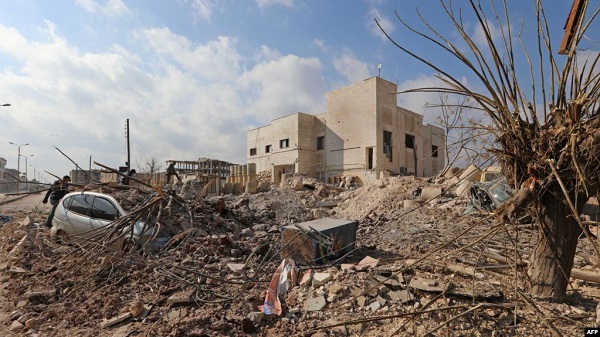Attacks on Civilians, Infrastructure in Syria Might Be War Crimes
Attacks on Civilians, Infrastructure in Syria Might Be War Crimes
Lisa Schlein - VOA News

Destruction is seen around the Udai hospital following airstrikes on the town of Saraqeb in Syria's northwestern province of Idlib, Jan. 29, 2018.
GENEVA - The United Nations is demanding an immediate end to indiscriminate attacks against civilians and civilian infrastructure in northwest Syria, warning the warring parties their actions might amount to war crimes.
U.N. agencies say an intense military escalation by Russian-backed Syrian forces and armed rebels in northwest Syria is having a catastrophic impact on the civilian population. Agencies confirm at least 160 civilians have been killed and hundreds more wounded in fighting over recent weeks.
They say 3 million people in Idlib need protection and 300,000 civilians who have fled their homes in the past two months are in imminent danger.
Spokesman for the U.N. Office for the Coordination of Humanitarian Affairs Jens Laerke says civilians and civilian infrastructure are coming under daily attack by airstrikes, artillery shelling and barrel bombs.
"Since the 28th of April, there have been 25 confirmed attacks on health care in the northwest, including on 24 health facilities and one ambulance," he said. "Two of the attacked health facilities were hit more than once, and at least six health workers have been killed."
Laerke says health care facilities are fully protected under international humanitarian law, and it is illegal to target them. Few health facilities remain intact to care for the sick and wounded, he told VOA.
"Already before the recent months of escalation, the status of health care in Syria at large, and in particular in Idlib, was already appalling," he said. "Even though those facilities have not been hit, they fear that they may be hit. So, the doctors, the health care personnel are leaving, the patients are not going to those hospitals. Understandably."
Laerke says aid agencies are providing food and health services through mobile clinics to people who are newly displaced in northwest Syria. In addition, many schools in the region have been attacked, he says, so catch-up classes are being provided for thousands of children who have been out of school since May.
